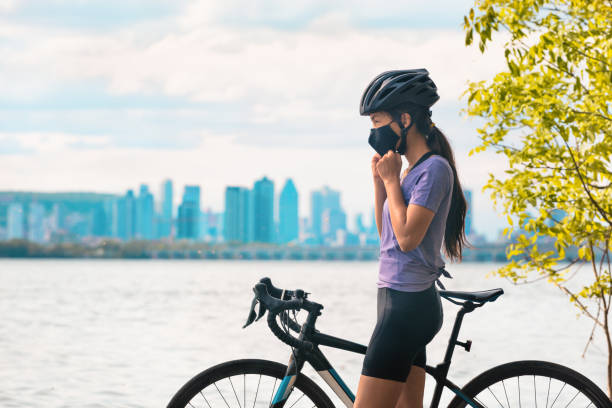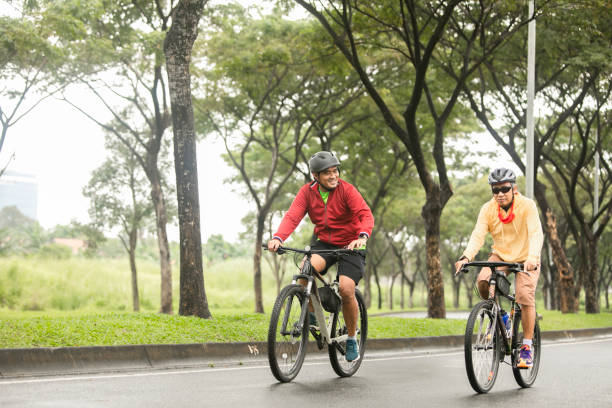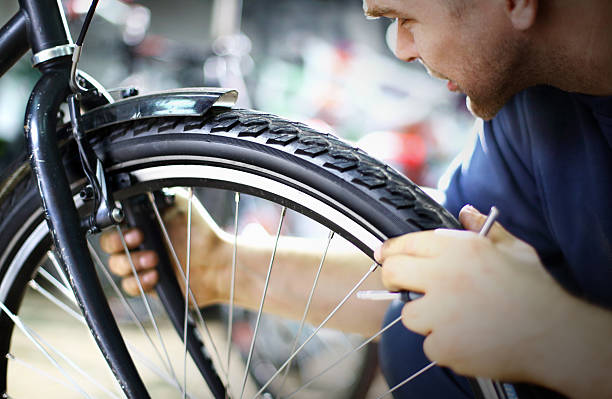Cycling is a highly beneficial exercise for boosting cardiac health and promoting muscle growth. In the process of biking, the main muscular groups in your body’s lower half are put to work more strenuously. In addition to fortifying the strength of your leg muscles, it’s equally vital to train your upper body in order to sustain balance.
If you train your lower body for cycling, you will get great lower body strength (and probably not much upper body strength). The problem is that most people don’t have the balance between their upper and lower bodies to do this. You need to train both for cycling. If you only train your lower body, you won’t get the full benefit of training your muscles together.
If you only train your upper body, you will get good upper body strength but not much lower body strength. Training your lower body will give you good lower body strength. This is the best type of cycling strength training. It is the most effective way to increase cycling speed, endurance, and strength. It is all about balance.
The Six Key Muscle Groups Used in Cycling
Cycling is a great way to get exercise and spend time outdoors. While many people think of the leg muscles when cycling, other muscle groups are also used. The six main muscles used in cycling are the gluteus maximus, hamstrings, quadriceps, gastrocnemius, soleus, and tibialis anterior. These muscles work together to power the bicycle. These muscles are not only used in cycling; they are also used in running, walking, jumping, lifting weights, and using the arms.

Gluteus Maximus
One of the most important muscles for cycling is the gluteus maximus. This muscle is responsible for extending your hip and helps to power your pedal stroke. To properly train this muscle, you need to know how it functions and which exercises target it.
How to Train Gluteus Maximus for Cycling?
Cycling is a great lower body workout, and it’s especially good for targeting the gluteal muscles. To get the most out of your cycling routine, you need to ensure that these muscles are properly trained. Here are a few tips on how to do just that:
- Start by doing some basic squats. This will help to activate the targeted muscles.
- Use a kettlebell or dumbbell to work your glutes. You can do this by simply holding the weight in front of you and, with one leg, lunging forward until your knee is almost bent over your toes. This will help to engage the muscles of the gluteus maximus.
- Finally, try to balance one leg while doing some lunges or squats with the other leg. This will help to activate both the gluteus maximus and the hamstrings.

Hamstrings
Cycling is a great cardiovascular workout, but it can also inflict knee pain and other joint pains. A big part of cycling is using your leg muscles, especially your hamstrings. The hamstrings are the muscles at the back of your thigh, and they help you extend your leg when you pedal. If you don’t use them correctly or are not strong enough, you can have pain in your knees or other problems.
How to Train Hamstrings for Cycling?
Cycling is a great exercise, but it can be tough on the leg muscles. To protect your legs and get the most out of your cycling, you need to know how to train your hamstrings. The hamstrings are a group of muscles in the back of the leg responsible for bending the knee and extending the hip. They are used extensively in cycling, so it’s important to make sure they are strong and flexible. The hamstrings can be trained using a variety of exercises, including squats, lunges, leg presses, and leg curls.
The best way to train your hamstrings is to do a series of sets of 10-12 reps. The main muscles of the hamstrings are the semimembranosus, semitendinosus, and biceps femoris.
To train your hamstrings, you will need a resistance band or cable. The band can be wrapped around the legs, and then you can squat down until your knees are at 90°. The resistance will be applied to the hamstrings by holding the band/cable tight against your leg. Hamstrings are involved in many sports, including tennis, rugby, American football, and soccer.
The hamstrings are often a primary muscle group for explosive movements such as injury-avoidance tackles and fast sprinting in these sports. The hamstrings also play a major role in sprinting because they are used to accelerate the leg, but they also play a role in decelerating the leg by slowing it down through the hip extension phase.
The hamstring muscles flex and extend your legs. The hamstrings are very susceptible to injury because of their location. They are not tucked away in a safe spot but lie right along the knee joint. The hamstrings are composed of three muscles: the biceps femoris, semimembranosus, and semitendinosus.
The hamstring muscles attach to the ischium, pubic bone, and fibula bones. Stretching is the primary means of injury prevention. Proper stretching improves range of motion flexibility and can help prevent injuries when the muscles are at their weakest. Stretching can be done with a foam roller, a lacrosse ball, or by using the body weight.

Quadriceps Muscles
The quads, or quadriceps, are a set of four muscles on the front of the thigh. They work together to extend the knee and stabilize the femur (thigh bone). The quads are used extensively in cycling, so it’s important to understand how they work and what you can do to keep them healthy.
The main function of the quadriceps is to extend the knee or extend the thigh muscles. This means they also help you straighten your leg and maintain balance while standing on one leg. The quads are also important for walking and running because they stabilize the knee joint during each step.
How to Train Quadriceps for Cycling?
- Make sure that you are performing regular squats and lunges. These exercises will help to strengthen your quadriceps muscles.
- Try adding some weightlifting to your routine. Third, make sure to stretch after you exercise.
- Ride in a very low gear and work on pedaling efficiently with the quads.
- Make sure to always drink plenty of water and avoid excessive caffeine.

Gastrocnemius
The gastrocnemius muscle is located in the back of the lower leg. It is responsible for pointing the toes and lifting the heel off the ground. When cycling, it is important to keep this muscle strong so that you can generate power through the pedal stroke. There are several exercises you can do to strengthen the gastrocnemius.
How to Train Gastrocnemius Muscle for Cycling?
The gastrocnemius muscle is one of the main muscles used in cycling, and it’s important to make sure this muscle is strong and well-trained if you want to be a successful cyclist. It comes from the calf muscles, located on the backside of the lower leg. The gastrocnemius muscles are also called calf muscles.
Using a single-leg exercise machine can help you strengthen the gastrocnemius muscle.
You may also read: Best Cross Trainers for Home
Start the movement by lifting your non-working leg up and out to the side. Then, move it forward to straighten your foot and in line with your knee. After that, straighten your knee and keep your heel on the ground. Then, slowly lower your leg back down until it’s in line with the other knee. Make sure you don’t move your knee too far forward or backward.
It would be best to focus on keeping the movement slow and controlled.
Do this exercise three to five times a week for 30 minutes at a time.
Soleus
The main muscles used are the quadriceps, and the hamstrings are key muscle groups for cycling. But there are also many smaller muscles in your legs that play an important role in cycling. One of these is the soleus muscle. This muscle originates on the inside of the tibia and runs down to the back of your heel.
The Soleus muscle is made up of two parts:
- The anterior fibers run from just below your knee to above the ankle.
- The posterior fibers run from the back of your knee to just above your ankle.
How to Train Soleus Muscle?
One of the key muscles you need to train is your soleus muscle when cycling. This muscle is responsible for stabilizing your ankle and providing power during the downstroke of the pedal rotation. Here are a few tips on how to train your soleus muscle:
- Start by doing calf raises. You can do these either with your body weight or with added weight.
- The best way to train your soleus muscle is by cycling. Cycling will work your soleus muscle’s anterior fibers and improve overall leg strength.
- You can also do regular squats, lunges, and calf raises to target the posterior fibers of your soleus muscle.
- If you want to get a great workout in a short amount of time, you can do some stair running. Stair running is an excellent way to build up your cardio and leg strength.

Tibialis Anterior
The tibialis anterior muscle is located on the front of the shin. It helps to pull the foot upward and assists in ankle stabilization. This muscle can be used to generate power when pedaling a bicycle. To use the tibialis anterior muscle effectively when cycling, you need to know its role in the pedal stroke and how to engage it. You may also need to adjust your bike fit and position to ensure that you are using this muscle effectively.
How to Train Tabialis Anterior?
The tibialis anterior is a muscle located in the front of your leg. It’s responsible for flexing your ankle and toes and is important for cycling. Here’s how to train it:
- Perform ankle curls with a weight or resistance band.
- Do toe raises by standing on an elevated surface and raising your heels as high as possible.
- Walk around with your heels down, and then raise them to their original position.
- Perform toe raises with a resistance band or weight.
- Do ankle curls, and then raise your heels to their original position.
The anterior tibialis muscle is one of the most important muscles for cycling, especially if you want to perform a powerful pedal stroke as sprinters do. It’s also important to make sure your ankles and toes can move when you’re riding.
Conclusion
Cycling is a great way to reap health benefits such as cardiovascular health and strengthen your legs muscles. However, there are some things you need to know to make sure you’re getting the most out of your cycling routine. Be sure to warm up and stretch properly before each ride, and make sure you’re incorporating both resistance and endurance exercises into your routine. By following these tips, you can maximize your cycling workout and see improvements in your lower body muscle groups in no time!





